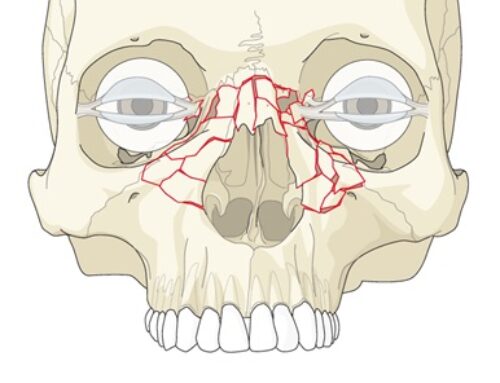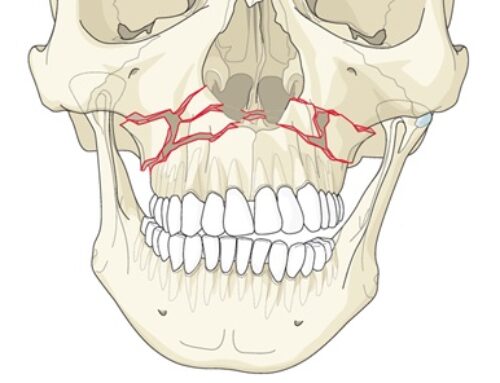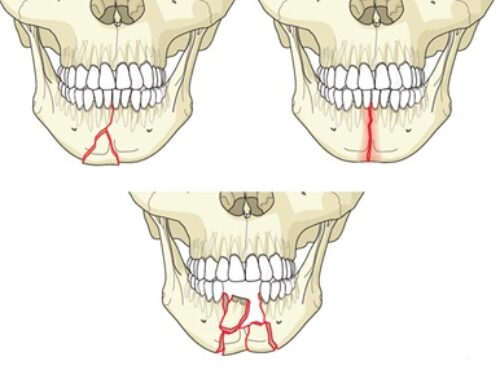Structures Within the Bony Orbit
- Anterior ethmoidal foramen transmits the anterior ethmoidal artery and anterior ethmoidal branches of the nasociliary nerve
- Posterior ethmoidal foramen transmits the posterior ethmoidal artery and the spheno-ethmoidal nerve from the nasociliary nerve
- Optic foramen trasmits the optic nerve and ophthalmic artery
Distance From Lacrimal Crest
- Anterior ethmoid – 24mm
- Posterior ethmoid – 36 mm
- Optic canal – 42 mm
Extraocular Muscles
| EOM | Innervation | Action |
|---|---|---|
| Lateral Rectus | Abducens (CN VI)LLa | Abduction; moves the eye laterally |
| Superior Rectus | Oculomotor Nerve (CN III) | Elevation; moves eye superiorly |
| Medial Rectus | Oculomotor Nerve (CN III) | Adduction; moves the eye medially |
| Inferior Rectus | Oculomotor Nerve (CN III) | Depression; moves eye inferiorly |
| Superior Oblique | Trochlear (CN IV) | Intorsion; moves eye down-and-out |
| Inferior Oblique | Oculomotor Nerve (CN III) | Extortion; moves eye up-and-out |
Landmarks within the Eye and Key Points
- Iridocyclitis: traumatic anisocoria and many times points towards the injury.
- Intercanthal distance: average distance in adult Caucasians is 33 + 2mm. This varies minimally with gender and race.
- Murphy WK, Laskin DM: Intercanthal and interpupillary distance in the black population. Oral Surg Oral Med Oral Pathol 69:676, 1990
- Annulus of Zinn: contains the ophthalmic artery and its branches. The oblique muscles originate outside of the annulus. The annulus is distant from the lacrimal bone, and does not contain the maxillary division of the trigeminal nerve.
- Lacrimal gland: found in the upper eyelid and not in the lower eyelid. The middle and lateral fat pads are close to each other and are not separated by a muscle.
- Inferior oblique muscle: lies in between the nasal and middle fat pads and must be protected during fat excision in this area. It is especially prone to damage in transconjuctival lower eyelid blepharoplasty procedures.
- Orbital septum: direct extension from the periosteum of the orbit and separates the preseptal and postseptal orbital components.
- Whitnall’s tubercle: slightly raised prominence in the lateral orbital rim on the zygoma which serves as an attachment for the lateral canthal ligament.
- Tarsal plates: comprised of dense connective tissue and are located in both the upper and lower eyelids. The tarsal plates help form and support the shape of the eyelids.
- Lockwood’s ligament is a fascial suspensory ligament which helps maintain the vertical position of the globe within the orbit.
Indications to Treat Orbital Fractures
- Globe asymmetry of 2 to 4mm of globe malposition
- Orbital floor defects of >50% the surface area
- Unresolved diplopia
- Muscle entrapment
- Ophthalmoplegia
Oculocardiac Reflex (Aschner Reflex)
Oculocardiac Reflex is a reduction of the heart rate resulting from direct pressure placed on the extraocular muscles (EOM), globe, or conjunctiva. The reflex begins with the activation of stretch receptors in periorbital and ocular tissues. The long and short ciliary nerves carry the impulses to the ciliary ganglion, where the ophthalmic division of CN V carries the impulses to the Gasserian ganglion, and subsequently to the trigeminal nucleus. The afferent nerves synapse with the visceral motor nucleus of the vagus nerve in the reticular formation of the brain stem, where the impulses are then carried to the myocardium to activate the vagal motor response at the sinoatrial (SA) node, resulting in bradycardia.
- Afferent limb: carried by the trigeminal nerve (CN V)
- Efferent limb: carried by the vagus nerve (CN X)
- Avoid sudden or sustained traction on EOMs
- If the OCR is triggered, immediately remove the inciting stimulus
- If removal of stimulus does not stabilize the patient, administer IV anticholinergic (e.g. atropine or glycopyrrolate)
- 1st line tx: atropine (0.5mg every 3-5min to a max of 3mg)
- In the event of an OCR refractory to anticholinergic administration, add epinephrine and institute cardiopulmonary resuscitation
- 2nd line tx: epinephrine (2-10mcg/min)
- Transcutaneous pacing is indicated for the treatment of symptomatic bradycardia if patient fails to respond to atropine
Complications of Eye Trauma
Retrobulbar Hematoma
- Can lead to blindness in 0.3%
- Can present with: tense proptosis, eye pain, elevated intraocular pressure, visual disturbances
- Normal intraocular pressure – 11-20mmHg
- Treatment
- Evidence of optic neuropathy or severely raised IOP >40mmHg -> lateral canthotomy and cantholysis
- No evidence of optic neuoropathy but IOP >30mmHg -> treat with agents used to lower IOP (e.g. acetazolamide or topical Timolol)
Traumatic Hyphema
- Rebleeding occurs in 5-30% of patients with hyphema
- Treatment: decrease IOP with topical cycloplegics and carbonic anhydrase inhibitors
- Corneal staining from myoglobin is the primary cause of permanent vision loss
Lateral Canthotomy & Cantholysis
Treatment of choice for acute visual acuity loss associated with acute orbital compartment syndrome is dissection of the lateral canthus and disinsertion of the inferior curs of the lateral canthal tendon, which allows complete mobility of the lower lid.
- Signs and symptoms of visual impairment, severe ocular pain should be evaluated for retrobulbar hematoma. Immediate treatment with a lateral canthotomy based on clinical symptoms and signs should be performed prior to obtaining a CT scan. Other signs of optic nerve compromise include: afferent papillary defect, visual field loss, color vision defects.
- Patients with traumatic optic neuropathy with no light perception have a poor prognostic factor.
- Penetrating injuries have worse prognosis than blunt trauma.
Retrobulbar Hematoma (Orbital Compartment Syndrome)
- Irreversible ischemic damage often occurs within 60min. High dose steroids are recommended during first 8 hours following surgery.
Indications for lateral canthotomy and cantholysis
- IOP >40 mm Hg and proptosis (may be used as a criterion for unconscious patients whose visual acuity cannot be determined)
- Visual acuity loss
Secondary indications
- Afferent papillary defect
- Ophthalmoplegia
- Cherry red macula
- Optic nerve head pallor
- Severe ocular pain
- *All are considered less sensitive or very late signs
Contraindications
- Suspected ruptured globe
Lateral Canthotomy & Cantholysis Procedure
- The tip of the pointed scissors is inserted within the palpebral fissure, extending laterally to the depth of the underlying lateral orbital rim (approximately 7 to 10m)
- Cut skin, orbicularis oculi muscle, orbital septum, lateral canthal tendon, conjunctiva
- To perform the inferior cantholysis, scissors are positioned vertically downward and the inferior limb of the lateral canthal tendon is then cut
Frost Suture
- Suture is placed through the gray line of the lower eyeylid, into the tarsus, and then exits the gray line at approximately 5mm from the point where it entered
- A first layer of tape is applied to the skin. The suture is positioned over the first layer and a second tape is applied over it. The suture is folded over this second tape and a third strip of tape is applied over the suture
Surgical Anatomy
Lower-Eyelid Anatomy
- C: palpebral conjunctiva
- IO: inferior oblique muscle
- IR: inferior rectus muscle
- OO: orbicularis oculi muscle
- OS: orbital septum
- P: periosteum/periorbita
- LLR: lower lid retractor
- TP: tarsal plate.
Upper-Eyelid Anatomy
- C, palpebral conjunctiva
- LA, levator palpebral superioris aponeurosis
- MM, Müller muscle
- OO, orbicularis oculi muscle
- OS, orbital septum
- P, periosteum/periorbita
- TP, tarsal plate
Approaches to the Orbit
- Subciliary incision has an ectropion rate of approximately 6%
- Transconjunctival incision has an ectropion/entropion rate of 1.2%
Transcutaneous Lower-Eyelid Approaches
- Subciliary – highest incidence of post operative scleral show
- Subtarsal
- Infraorbital
Transcutaneous Lower-Eyelid Approaches
- Transconjunctival
- Transcaruncular
- Trasconjunctival with lateral skin extension
Approaches to the Superolateral Orbital Rim
- Lateral Eyebrow Approach
- Upper-Eyelid Approach
Subciliary Approach
AKA – infraciliary, blepharoplasty
- Mark planned skin incision 2mm inferior to the eyelashes paralleling the lid margin. Lateral extension runs out into a natural crease (up to 2cm past the lateral canthus without damage to temporal branch of facial nerve)
- Injection local anesthesia with vasoconstrictor
- Incision made through skin only and separate skin from pretarsal portion of orbicularis oculi
- Bluntly dissect through the orbicularis oculi to periosteum over lateral orbital rim. Supraperiosteal dissection over the anterior edge of the infraorbital rim. Sharply dissect orbicularis oculi over a Metsenbaum.
- Sharply incise periosteum 3-4mm below inferior orbital rim on the anterior surface maxilla/zygoma
Subtarsal Approach
AKA – mid-eyelid, skin crease approach
- Skin incision is marked at level of inferior margin of lower tarsus over a natural skin crease
- Injection local anesthesia with vasoconstrictor
- Incision is made through skin and muscle to depth of the orbital septum. Extended laterally past the bone of the lateral orbit
- Blunt dissection between orbital septum and orbicularis oculi muscle down to the level of the anterior edge of the infraorbital rim
- Sharply incise periosteum 3-4mm below inferior orbital rim on the anterior surface maxilla/zygoma
Transconjunctival Approach – Retroseptal
- Inject vasoconstrictor under the conjunctiva, place corneal shield, and place 3 traction sutures through the eyelid from the palpebral conjunctiva to skin (4-5mm below eyelid margin to include tarsal plate)
- Incision is made at the depth of the fornix
- Conjunctiva and lower-eyelid retractors are undermined towards the inner angle of the lid, then incised to expose the fat compartment behind the orbital septum
- Periosteum is sharply incised parallel but just posterior to the infraorbital rim
Transconjunctival Approach – Preseptal
- Inject vasoconstrictor under the conjunctiva, place corneal shield, and place 3 traction sutures through the eyelid from the palpebral conjunctiva to skin (4-5mm below eyelid margin to include tarsal plate)
- Incision is made below the lower tarsal border and the suborbicularis oculi/preseptal space is entered
- Blunt preseptal dissection until the infraortbial rim is reached
- Sharply incise periosteum 3-4mm below inferior orbital rim on the anterior surface maxilla/zygoma
Upper Eyelid Approach
AKA: upper blepharoplasty, upper eyelid crease, supratarsal fold approach
- Protect the globe with a tarsorrhaphy or scleral shell after application of bland eye ointment
- Local anesthesia with a vasoconstrictor is injected under the eyelid skin and the orbicularis oculi muscle
- A curvilinear incision is made through skin and orbicularis oculi along the supratarsal fold that tails off laterally over the lateral orbital rim. The incision should be 10mm superior to the upper eyelid margin and should be 6mm above the lateral canthus as it extends laterally
- A skin-muscle flap is developed superiorly, laterally, and if necessary medially using scissors to dissect the orbicularis oculi muscle, exposing the periosteum
- The periosteum is incised in the middle of the orbital rim with a scalpel
- Wound is closed in 3 layers – periosteum, orbicularis oculis muscle, skin
Visual Fields and Deficits

























